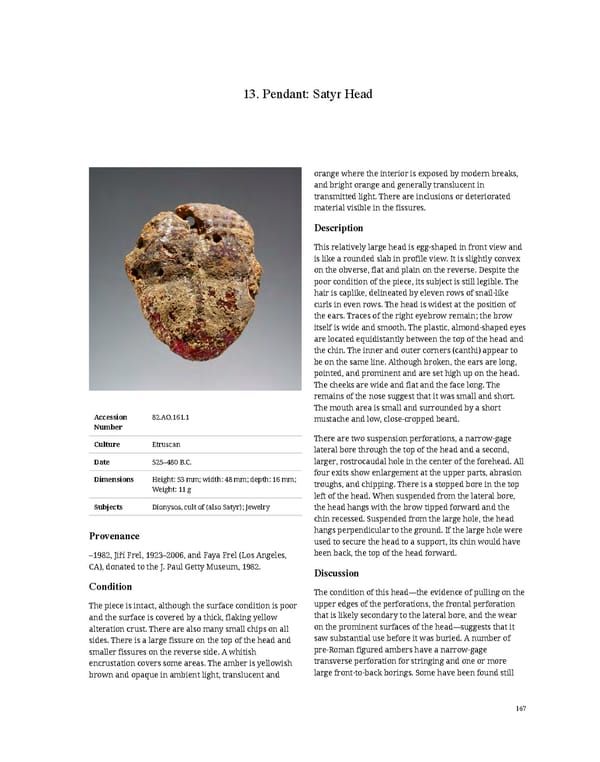13. Pendant: Satyr Head orange where the interior is exposed by modern breaks, and bright orange and generally translucent in transmitted light. There are inclusions or deteriorated material visible in the fissures. Description This relatively large head is egg-shaped in front view and is like a rounded slab in profile view. It is slightly convex on the obverse, flat and plain on the reverse. Despite the poor condition of the piece, its subject is still legible. The hair is caplike, delineated by eleven rows of snail-like curls in even rows. The head is widest at the position of the ears. Traces of the right eyebrow remain; the brow itself is wide and smooth. The plastic, almond-shaped eyes are located equidistantly between the top of the head and the chin. The inner and outer corners (canthi) appear to be on the same line. Although broken, the ears are long, pointed, and prominent and are set high up on the head. The cheeks are wide and flat and the face long. The remains of the nose suggest that it was small and short. The mouth area is small and surrounded by a short Accession 82.AO.161.1 mustache and low, close-cropped beard. Number Culture Etruscan There are two suspension perforations, a narrow-gage lateral bore through the top of the head and a second, Date 525–480 B.C. larger, rostrocaudal hole in the center of the forehead. All Dimensions Height: 53 mm; width: 48 mm; depth: 16 mm; four exits show enlargement at the upper parts, abrasion Weight: 11 g troughs, and chipping. There is a stopped bore in the top left of the head. When suspended from the lateral bore, Subjects Dionysos, cult of (also Satyr); Jewelry the head hangs with the brow tipped forward and the chin recessed. Suspended from the large hole, the head Provenance hangs perpendicular to the ground. If the large hole were used to secure the head to a support, its chin would have –1982, Jiří Frel, 1923–2006, and Faya Frel (Los Angeles, been back, the top of the head forward. CA), donated to the J. Paul Getty Museum, 1982. Discussion Condition The condition of this head—the evidence of pulling on the The piece is intact, although the surface condition is poor upper edges of the perforations, the frontal perforation and the surface is covered by a thick, flaking yellow that is likely secondary to the lateral bore, and the wear alteration crust. There are also many small chips on all on the prominent surfaces of the head—suggests that it sides. There is a large fissure on the top of the head and saw substantial use before it was buried. A number of smaller fissures on the reverse side. A whitish pre-Roman figured ambers have a narrow-gage encrustation covers some areas. The amber is yellowish transverse perforation for stringing and one or more brown and opaque in ambient light, translucent and large front-to-back borings. Some have been found still 167
 Ancient Carved Ambers in the J. Paul Getty Museum Page 176 Page 178
Ancient Carved Ambers in the J. Paul Getty Museum Page 176 Page 178